
Image Credit: Elnur/Shutterstock.com
With a recent rise in the research and application of digital technologies, the solutions capable of assessing the needs of a potential customer or a user based on their emotional state is increasing drastically, including in areas such as marketing, automation, and entertainment.
One promising area of research has focused on boosting automobile safety via multi-media solutions that identify and adjust to a driver's emotional state. In one study, researchers designed and applied a virtual reality environment to gather physiological data from individuals experiencing driving-related emotional states.
A significant amount of the newest scientific research presents new techniques to classify emotions, which are usually considered a mental and physical reaction to a stimulus. Because one or more emotions can have overlapping factors, many studies on sensing emotions use different measurements of emotions, including valence (negative or positive stimuli) and arousal.
The recognition and evaluation of emotions are complex due to their interdisciplinary nature. Psychology, medical sciences, data analysis, and mechatronics are just a few scientific disciplines that may be involved.
Below are a few ways that sensors are used to detect human emotions, and any associated related developments.
Body Posture, Facial Expression and Gesture Analysis
The benefits and challenges of these techniques come from the fact that there are lots of reference points that can be observed. For instance, the Facial Action Coding System (FACS) uses combinations of 64 parameters to recognize emotions.
In the most recent research, computer vision systems are used to track body posture, facial expressions, and gestures based on specific reference points. One major benefit of this approach is that it can be done in a contactless manner. Research has also produced very reliable results, with some experts saying the tracking of body posture, facial expressions, and gestures is very promising for future applications. These approaches are particularly useful in situations that do not require a high degree of accuracy or sensitivity.
One of several most encouraging areas for facial expression analysis is the Internet of Things. "Smart" objects that are capable of responding to users’ emotional states could be used to produce more personalized experiences in advertising, entertainment, medicine, robotics, and many other fields.
Real-time, off-line techniques are available, enabling in-depth analysis and a wide range of human testing situations.
Electroencephalography (EEG)
EEG is a non-invasive method of documenting electrical activity in the brain. In research settings, electrodes are often connected to the scalp using a conductive gel or close-fitting headset equipped with electrodes.
To assess emotions, the brain's reaction to stimuli can be measured and assessed using five frequency ranges: delta, theta, alpha, beta, and gamma. These frequencies are ubiquitous across different parts of the brain and analyses have linked certain patterns to specific emotional states.
The key focus of EEG-enabled research involves new techniques for data extraction, often involving machine learning methods. With research often using many kinds of other sensor data, big data methods and IoT implementation is expected to open new avenues in both research and applications.
Electrocardiography (ECG)
Given that heart activity is related to our central nervous system, ECG can analyze heart activity to recognize emotional factors, typically when used in addition to other emotion recognition methods. Present research concentrates on the development of new techniques for useful data extraction, indicating ECG-based emotion assessment is a great channel for the execution of emerging machine-learning techniques.
Galvanic Skin Response (GSR)
Not able to be consciously controlled, electrical variables of the skin are based on sweat production, which is driven by the sympathetic nervous system.
Skin conductance is principally related to the degree of emotional arousal. If the level of arousal is elevated, it leads to higher skin conductance. Thus, the amplitude of a GSR signal can be related to emotions such as stress, anger, or excitement. In research, GSR measurements are often correlated to self-reported assessments of arousal.
Recent GSR research involving the detection of emotions has focused on a few different directions. The first main direction concerns the combination of GSR with other methods. Another direction involves the investigation of wearable sensors. A third direction is centered around signal processing and analytic techniques which observe emotional responses with high reliability.
In one study, GSR was combined with heart rate monitoring to produce a stress-detection system. This study laid out a highly accurate, real-time application that applied fuzzy logic and behavior modeling under both stressful and non-stressful situations.
Heart Rate Variability (HRV)
Heart rate variability is a technique based on beat-to-beat changes in heart rate that are measured inside a certain time period, based on sinus rhythms. This method is focused on the nuance time variance in every cycle of a heartbeat with respect to regularity.
Recently, there has been greater interest in remote monitoring that makes it possible to track cardiovascular pulse data by gauging changes of back-scattered light, using ambient light and cost-effective vision systems. Remote measurements can substantially improve comfort level during measurement, but remote methods decrease the signal-to-noise ratio, raising the need for more sophisticated signal processing.
Fortunately, HRV monitoring equipment is low-cost and very accessible. Research has shown the touchscreen of a common smartphone could be used as a reliable sensor.
References and Further Reading
Dzedzickis, A. et al. Human Emotion Recognition: Review of Sensors and Methods. Sensors. [Online] Available at: https://www.ncbi.nlm.nih.gov/pmc/articles/PMC7037130/
Polacheck, M. 5 Companies that Want to Track Your Emotions. Fortune. [Online] Available at: https://fortune.com/2020/08/22/emotion-sensing-tracking-technology-apps/
Disclaimer: The views expressed here are those of the author expressed in their private capacity and do not necessarily represent the views of AZoM.com Limited T/A AZoNetwork the owner and operator of this website. This disclaimer forms part of the Terms and conditions of use of this website.